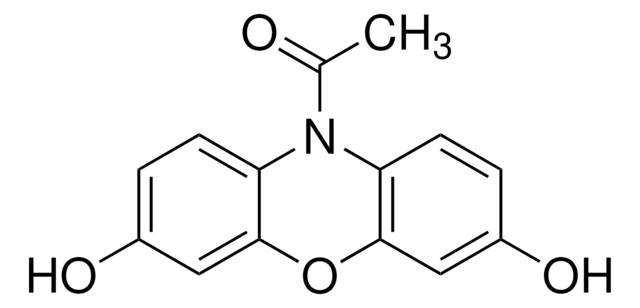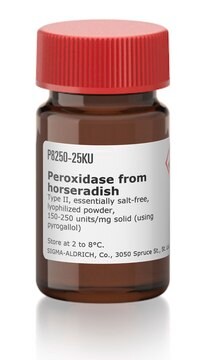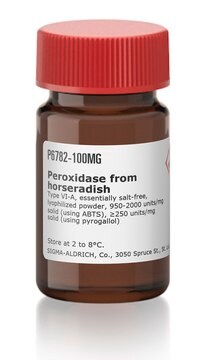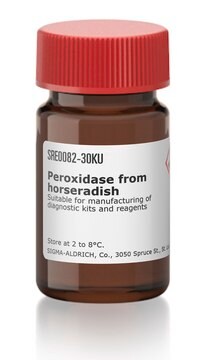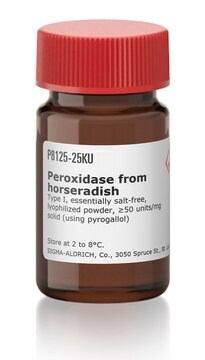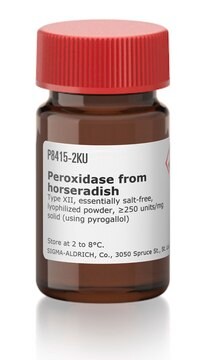10108090001
Roche
Peroxidase (POD)
grade I, from horseradish
Synonyme(s) :
POD, peroxidase
Se connecterpour consulter vos tarifs contractuels et ceux de votre entreprise/organisme
About This Item
Produits recommandés
Source biologique
horseradish
Niveau de qualité
Forme
lyophilized (salt-free)
Activité spécifique
≥250 units/mg protein (At 25 °C with guaiacol and H2O2 as the substrates.)
250 U/mg
Conditionnement
pkg of 25,000 U
Fabricant/nom de marque
Roche
pH optimal
6.0-6.5
Conditions d'expédition
wet ice
Température de stockage
2-8°C
Description générale
Donor:hydrogen-peroxide oxidoreductase
Peroxidase (POD) (E.C. 1.11.1.7) is extensively expressed in most fruits and vegetables.
Application
Oxidation of electron donors (e.g., epoxidation of double bonds). Peroxidase can be coupled to other proteins via its amino groups, as well as its carbohydrate moiety. The reconstituted solution can be used directly for conjugation without prior dialysis.It has been used in ligand blotting.
Peroxidase (POD) has been used in AUR (Amplex UltraRed assay) to measure extracellular H2O2 produced from disaggregated slug cells.
Actions biochimiques/physiologiques
Peroxidase (POD) is involved in the dehydrogenation of a large number of organic compounds including, phenols and aromatic amines, hydroquinones and hydroquinoid amines, mainly benzidine derivatives.
Qualité
Contaminants: <0.001% ATPase and acid phosphatase each, <0.7% catalase
Purity number: approximately 3.0 (A403/A275)
Purity number: approximately 3.0 (A403/A275)
Notes préparatoires
Activator: Ammonia, pyridine, imidazole, all at pH >7; detergents.
Working solution: PBS (phosphate buffered saline) or water (starting concentration 20 mg/ml).
Working solution: PBS (phosphate buffered saline) or water (starting concentration 20 mg/ml).
Reconstitution
Solution (10 mg/ml in water): clear, red brown; pH-value: 6.0 to 7.0.
Autres remarques
For life science research only. Not for use in diagnostic procedures.
Mention d'avertissement
Danger
Mentions de danger
Conseils de prudence
Classification des risques
Resp. Sens. 1 - Skin Sens. 1
Code de la classe de stockage
11 - Combustible Solids
Classe de danger pour l'eau (WGK)
WGK 1
Point d'éclair (°F)
Not applicable
Point d'éclair (°C)
Not applicable
Faites votre choix parmi les versions les plus récentes :
Déjà en possession de ce produit ?
Retrouvez la documentation relative aux produits que vous avez récemment achetés dans la Bibliothèque de documents.
Les clients ont également consulté
Methods of Enzymatic Analysis (1974)
Social amoebae trap and kill bacteria by casting DNA nets
Zhang X, et al.
Nature Communications, 7, 10938-10938 (2016)
Inactivation and conformational change of horseradish peroxidase induced by pulsed electric field
Zhong K, et al.
Food Chemistry, 92(3), 473-479 (2005)
Mi Kyong Lee et al.
Applied and environmental microbiology, 69(8), 4648-4657 (2003-08-07)
The Vip3A protein, secreted by Bacillus spp. during the vegetative stage of growth, represents a new family of insecticidal proteins. In our investigation of the mode of action of Vip3A, the 88-kDa Vip3A full-length toxin (Vip3A-F) was proteolytically activated to
Xuezhi Zhang et al.
Nature communications, 7, 10938-10938 (2016-03-02)
Extracellular traps (ETs) from neutrophils are reticulated nets of DNA decorated with anti-microbial granules, and are capable of trapping and killing extracellular pathogens. Various phagocytes of mammals and invertebrates produce ETs, however, the evolutionary history of this DNA-based host defence
Notre équipe de scientifiques dispose d'une expérience dans tous les secteurs de la recherche, notamment en sciences de la vie, science des matériaux, synthèse chimique, chromatographie, analyse et dans de nombreux autres domaines..
Contacter notre Service technique


